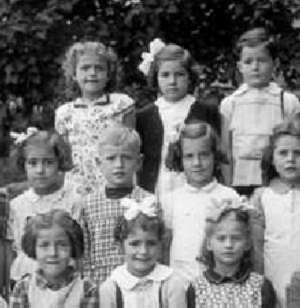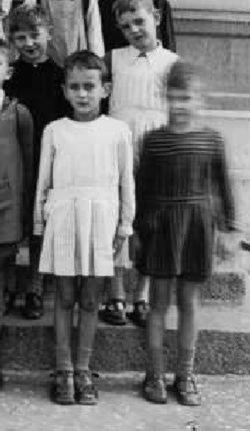
Figure 1.--While most school smocks were solid colors, ginham appears to be the most popular pattern of all the different patterns--both for boys and girls.


Figure 1.--While most school smocks were solid colors, ginham appears to be the most popular pattern of all the different patterns--both for boys and girls. |
Boys have worn a variety of patterns as school snocks.
The nmost common were of course solid color smocks, but patterns wee also worn. Some smocks came in checked gingham
patterns. This was probably the most common pattern, but there were others like stripped smocks. Often a school did not insist
on a certain pattern, but either just for the children to wear smocks. In other instances it was up to the parents to decide if a
child should wear a smock. In these instances the choice of pattern, if any, was up to the parents.
As HBC believes this to be primarily a French style, we will provide a French summary for out French readers. The French text may also be useful for English readers desiring to persue the subject in French sources as it provides the appropriate French terms: Pour les garçons il y avait une grande variété de styles pour les tabliers d'école. Les plus communs étaient naturellement des tabliers de couleur unie, mais des tissus à dessin genre vichy ou rayés étaient également portés.Le vichy était propablement le tissu le plus commun. Souvent
une école n' insistait pas pour un certain style, mais exigeait le port obligatoire du tablier. Dans d'autres cas il appartenait aux parents de décider si l' enfant devait porter un tablier et de choisir
style et couleur. Le terme de tablier communémemnt utilisé pour désigner un vêtement protecteur à l'origine définissait uniquement la pièce de tissu couvrant le devant et attachée dans le dos par deux bretelles croisées. Le tablier boutonné dans le dos est un sarrau et celui boutonné sur le devant (à droite pour les garçons, style à la russe) est une blouse.
Some basic information is available on the different pattern types.
The most popular pattern for smocks appears to have been the ginham smock. Both boys and girls wore this pattern. They were usually made in either blue or red, but there were other colors as well. The image here show that ginham was being worn at least by 1943-45. HBC notes ginham was worn much earlier as a popular smock material, but I am not sure when boys began wearing them to school.
Plaid was also a pattern popular for smocks. HBC has noted plaid smocks as one of the styles for French scvhool smocks in the 1960s, but is unsure just when boys began wearing them. The plais usually seem to use the red and blue color combinations.

Figure 2.--This 1943-45 Swiss image shows a rather wiggly little Swiss boy in a stripped smock who moved while his photograph was being taken. I'm not sure just what color his smock was. |
Stripped smocks were less common than other patterms, but they were made and worn to school (figure 2). HBC is not sure at this time why stripped patterns were not as popular as other patterns. I believe that this was not a design that a girl would normally wear, but I could be wrong about that.
HBC has noted a number of children wearing a variety of colored designs, mostly on a white background. Most commonly these designs were small flowers, but there were others as well. Almost always it was girls whonwore this pattern. Note the girl in the llower right of the above photograph (figure 1). This photograpgh shows tha the design patterns were being worn by 1943-45, but were not very common.
HBC is not sure at this time how boys reacted to these patterns. Surly the design patterns, especially the floral designs, were not popular as they were perceived as too girlish. I'm less sure about the other designs. Of course it was mother who made these decisions so it was probably more important what appealed to her.
HBC does not have sufficient information at this time to discuss national differences in school smock patterns. Most school smocks were solid colors, but patterned smocks were worn to school in some counties, although not on a nation-wide basis.
Navigate the Historic Boys' Clothing Web Site:
[Return to the Main school smock style page]
[Introduction]
[Activities]
[Bibliographies]
[Biographies]
[Chronologies]
[Contributions]
[Countries]
[Expanded Site]
[Frequently Asked Questions]
[Style Index]
[Boys' Clothing Home]
Navigate the Historic Boys' Clothing Web chronological pages:
[The 1890s]
[The 1900s]
[The 1910s]
[The 1920s]
[The 1930s]
[The 1940s]
[The 1950s]
[The 1960s]
Navigate the Historic Boys' Clothing Web style pages:
[Return to the Main school garment page]
[Return to the Main smocks page]
[Dresses]
[Bodice dresses]
[Kilts]
[Sailor suits]
[Sailor hats]
[Ring bearer/page costumes]
[Pinafores]
[Shortalls]
